5CHR Business Issues: CIPD Assignment 2, HR Role Development Report
VerifiedAdded on 2022/11/23
|20
|5618
|344
Report
AI Summary
This report examines the evolving role of Human Resources (HR) in contemporary businesses, using Tesco as a case study. It begins with an introduction and company overview, followed by an exploration of HR theories and models, including HR outsourcing and the Harvard Model. The report analyzes Tesco's business objectives and management structure, considering internal forces and external factors through PEST and SWOT analyses, along with Porter's Five Forces. It delves into strategy formulation, implementation, HR's contribution to business ethics, business performance indicators, and the role of HR in planning and change management. The report concludes with a discussion of the role of business data in planning, offering a comprehensive overview of the multifaceted responsibilities of HR in a modern business environment.
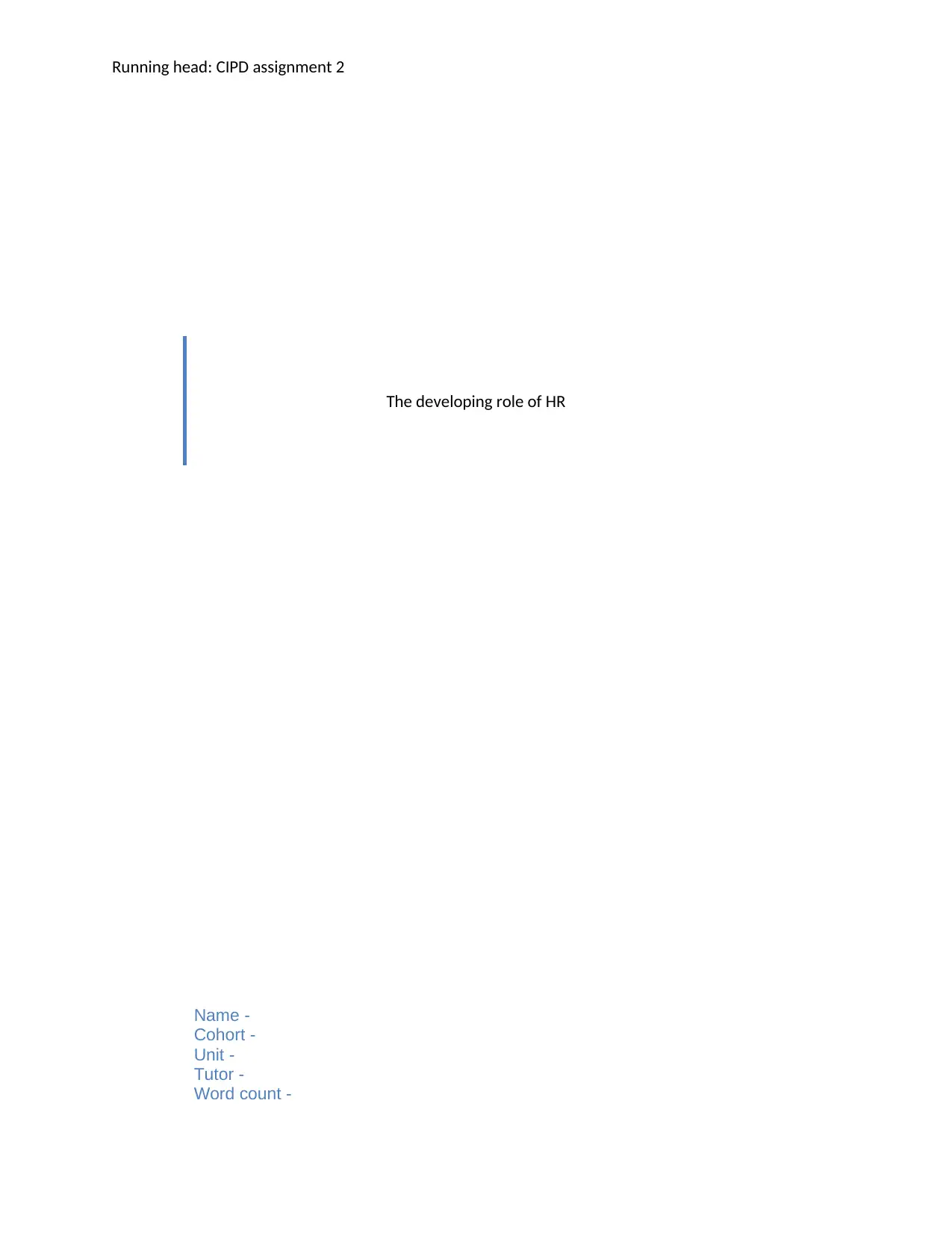
Running head: CIPD assignment 2
The developing role of HR
Name -
Cohort -
Unit -
Tutor -
Word count -
The developing role of HR
Name -
Cohort -
Unit -
Tutor -
Word count -
Paraphrase This Document
Need a fresh take? Get an instant paraphrase of this document with our AI Paraphraser
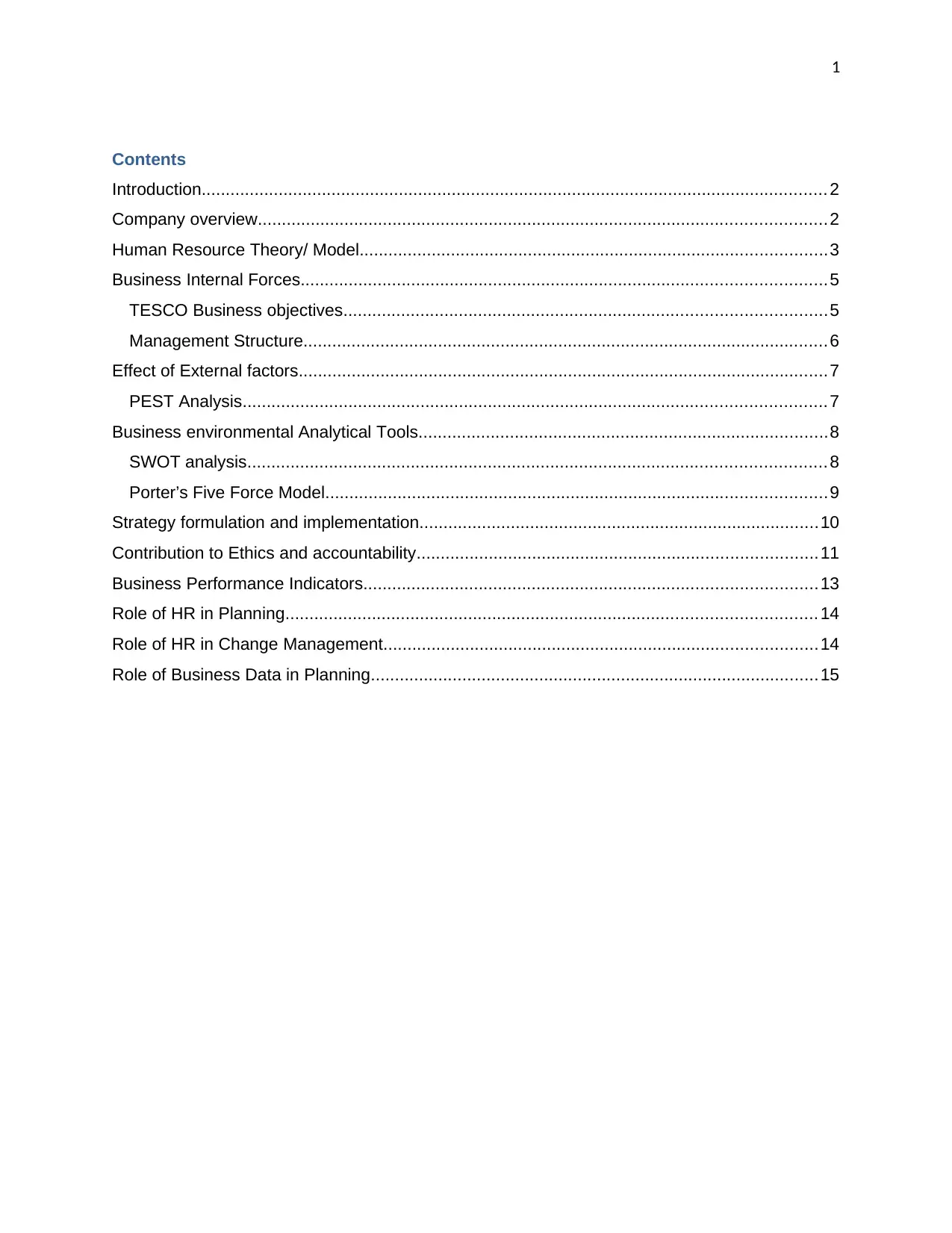
1
Contents
Introduction.................................................................................................................................. 2
Company overview...................................................................................................................... 2
Human Resource Theory/ Model.................................................................................................3
Business Internal Forces.............................................................................................................5
TESCO Business objectives....................................................................................................5
Management Structure............................................................................................................. 6
Effect of External factors..............................................................................................................7
PEST Analysis......................................................................................................................... 7
Business environmental Analytical Tools.....................................................................................8
SWOT analysis........................................................................................................................ 8
Porter’s Five Force Model........................................................................................................9
Strategy formulation and implementation...................................................................................10
Contribution to Ethics and accountability...................................................................................11
Business Performance Indicators..............................................................................................13
Role of HR in Planning.............................................................................................................. 14
Role of HR in Change Management..........................................................................................14
Role of Business Data in Planning.............................................................................................15
Contents
Introduction.................................................................................................................................. 2
Company overview...................................................................................................................... 2
Human Resource Theory/ Model.................................................................................................3
Business Internal Forces.............................................................................................................5
TESCO Business objectives....................................................................................................5
Management Structure............................................................................................................. 6
Effect of External factors..............................................................................................................7
PEST Analysis......................................................................................................................... 7
Business environmental Analytical Tools.....................................................................................8
SWOT analysis........................................................................................................................ 8
Porter’s Five Force Model........................................................................................................9
Strategy formulation and implementation...................................................................................10
Contribution to Ethics and accountability...................................................................................11
Business Performance Indicators..............................................................................................13
Role of HR in Planning.............................................................................................................. 14
Role of HR in Change Management..........................................................................................14
Role of Business Data in Planning.............................................................................................15
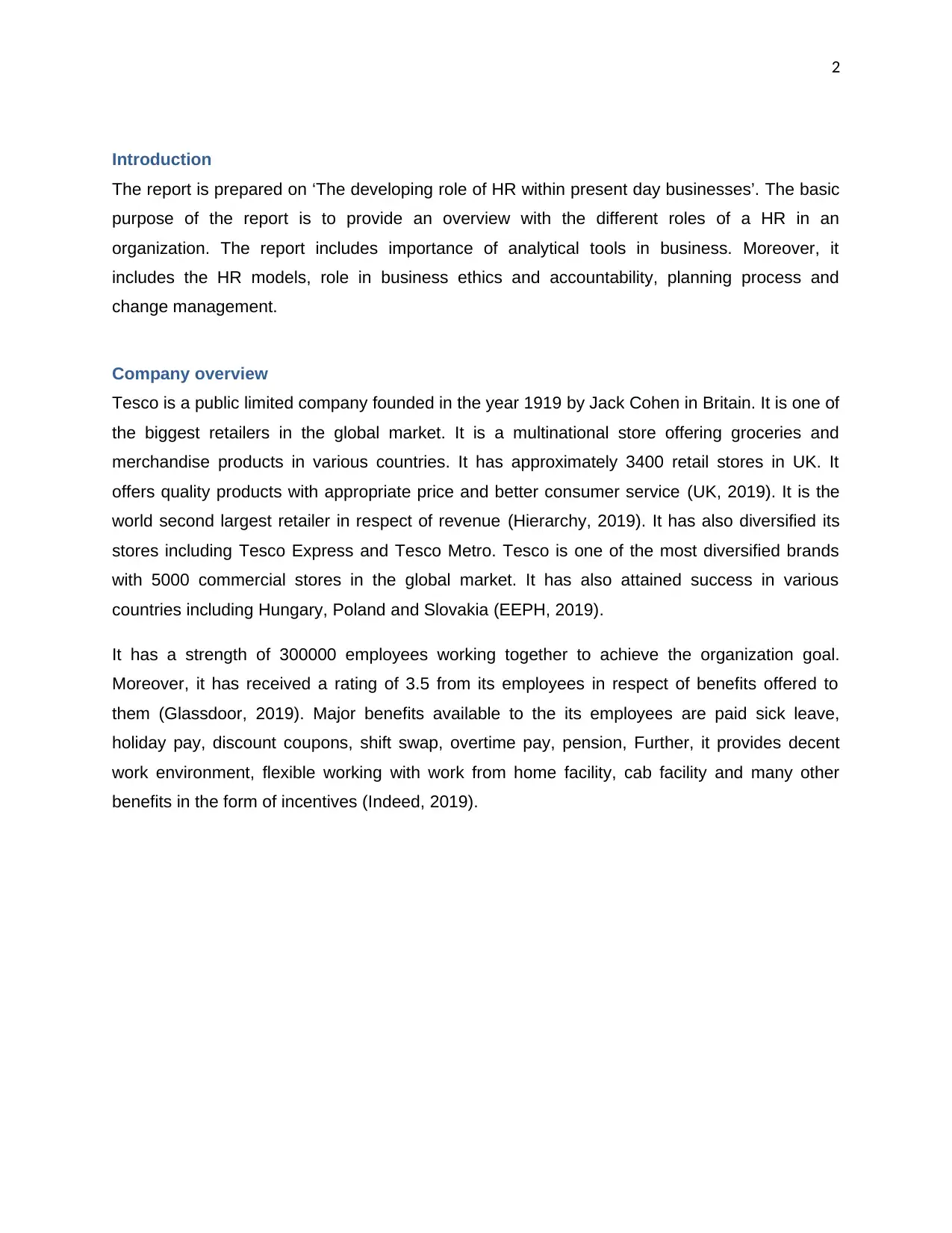
2
Introduction
The report is prepared on ‘The developing role of HR within present day businesses’. The basic
purpose of the report is to provide an overview with the different roles of a HR in an
organization. The report includes importance of analytical tools in business. Moreover, it
includes the HR models, role in business ethics and accountability, planning process and
change management.
Company overview
Tesco is a public limited company founded in the year 1919 by Jack Cohen in Britain. It is one of
the biggest retailers in the global market. It is a multinational store offering groceries and
merchandise products in various countries. It has approximately 3400 retail stores in UK. It
offers quality products with appropriate price and better consumer service (UK, 2019). It is the
world second largest retailer in respect of revenue (Hierarchy, 2019). It has also diversified its
stores including Tesco Express and Tesco Metro. Tesco is one of the most diversified brands
with 5000 commercial stores in the global market. It has also attained success in various
countries including Hungary, Poland and Slovakia (EEPH, 2019).
It has a strength of 300000 employees working together to achieve the organization goal.
Moreover, it has received a rating of 3.5 from its employees in respect of benefits offered to
them (Glassdoor, 2019). Major benefits available to the its employees are paid sick leave,
holiday pay, discount coupons, shift swap, overtime pay, pension, Further, it provides decent
work environment, flexible working with work from home facility, cab facility and many other
benefits in the form of incentives (Indeed, 2019).
Introduction
The report is prepared on ‘The developing role of HR within present day businesses’. The basic
purpose of the report is to provide an overview with the different roles of a HR in an
organization. The report includes importance of analytical tools in business. Moreover, it
includes the HR models, role in business ethics and accountability, planning process and
change management.
Company overview
Tesco is a public limited company founded in the year 1919 by Jack Cohen in Britain. It is one of
the biggest retailers in the global market. It is a multinational store offering groceries and
merchandise products in various countries. It has approximately 3400 retail stores in UK. It
offers quality products with appropriate price and better consumer service (UK, 2019). It is the
world second largest retailer in respect of revenue (Hierarchy, 2019). It has also diversified its
stores including Tesco Express and Tesco Metro. Tesco is one of the most diversified brands
with 5000 commercial stores in the global market. It has also attained success in various
countries including Hungary, Poland and Slovakia (EEPH, 2019).
It has a strength of 300000 employees working together to achieve the organization goal.
Moreover, it has received a rating of 3.5 from its employees in respect of benefits offered to
them (Glassdoor, 2019). Major benefits available to the its employees are paid sick leave,
holiday pay, discount coupons, shift swap, overtime pay, pension, Further, it provides decent
work environment, flexible working with work from home facility, cab facility and many other
benefits in the form of incentives (Indeed, 2019).
⊘ This is a preview!⊘
Do you want full access?
Subscribe today to unlock all pages.

Trusted by 1+ million students worldwide
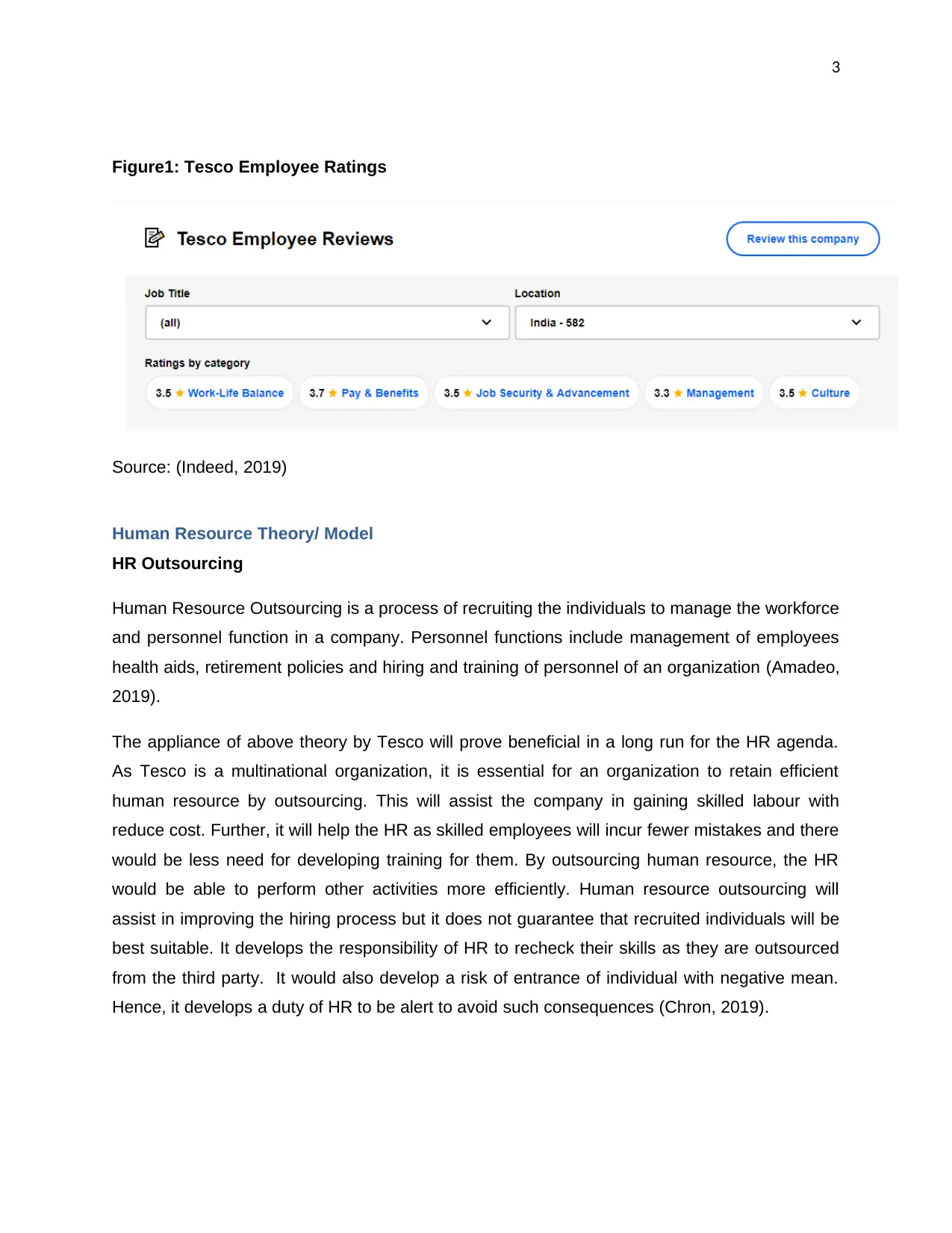
3
Figure1: Tesco Employee Ratings
Source: (Indeed, 2019)
Human Resource Theory/ Model
HR Outsourcing
Human Resource Outsourcing is a process of recruiting the individuals to manage the workforce
and personnel function in a company. Personnel functions include management of employees
health aids, retirement policies and hiring and training of personnel of an organization (Amadeo,
2019).
The appliance of above theory by Tesco will prove beneficial in a long run for the HR agenda.
As Tesco is a multinational organization, it is essential for an organization to retain efficient
human resource by outsourcing. This will assist the company in gaining skilled labour with
reduce cost. Further, it will help the HR as skilled employees will incur fewer mistakes and there
would be less need for developing training for them. By outsourcing human resource, the HR
would be able to perform other activities more efficiently. Human resource outsourcing will
assist in improving the hiring process but it does not guarantee that recruited individuals will be
best suitable. It develops the responsibility of HR to recheck their skills as they are outsourced
from the third party. It would also develop a risk of entrance of individual with negative mean.
Hence, it develops a duty of HR to be alert to avoid such consequences (Chron, 2019).
Figure1: Tesco Employee Ratings
Source: (Indeed, 2019)
Human Resource Theory/ Model
HR Outsourcing
Human Resource Outsourcing is a process of recruiting the individuals to manage the workforce
and personnel function in a company. Personnel functions include management of employees
health aids, retirement policies and hiring and training of personnel of an organization (Amadeo,
2019).
The appliance of above theory by Tesco will prove beneficial in a long run for the HR agenda.
As Tesco is a multinational organization, it is essential for an organization to retain efficient
human resource by outsourcing. This will assist the company in gaining skilled labour with
reduce cost. Further, it will help the HR as skilled employees will incur fewer mistakes and there
would be less need for developing training for them. By outsourcing human resource, the HR
would be able to perform other activities more efficiently. Human resource outsourcing will
assist in improving the hiring process but it does not guarantee that recruited individuals will be
best suitable. It develops the responsibility of HR to recheck their skills as they are outsourced
from the third party. It would also develop a risk of entrance of individual with negative mean.
Hence, it develops a duty of HR to be alert to avoid such consequences (Chron, 2019).
Paraphrase This Document
Need a fresh take? Get an instant paraphrase of this document with our AI Paraphraser
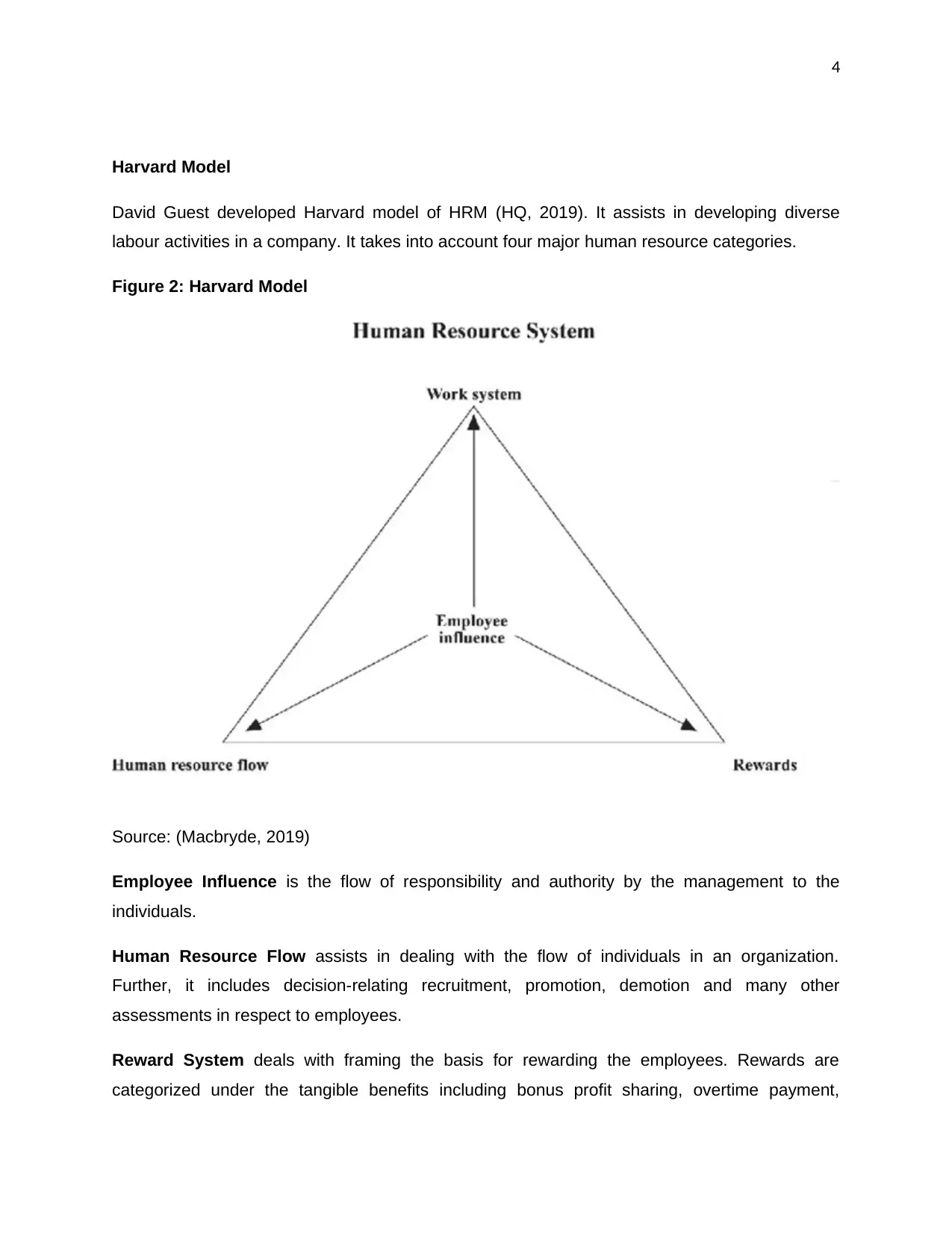
4
Harvard Model
David Guest developed Harvard model of HRM (HQ, 2019). It assists in developing diverse
labour activities in a company. It takes into account four major human resource categories.
Figure 2: Harvard Model
Source: (Macbryde, 2019)
Employee Influence is the flow of responsibility and authority by the management to the
individuals.
Human Resource Flow assists in dealing with the flow of individuals in an organization.
Further, it includes decision-relating recruitment, promotion, demotion and many other
assessments in respect to employees.
Reward System deals with framing the basis for rewarding the employees. Rewards are
categorized under the tangible benefits including bonus profit sharing, overtime payment,
Harvard Model
David Guest developed Harvard model of HRM (HQ, 2019). It assists in developing diverse
labour activities in a company. It takes into account four major human resource categories.
Figure 2: Harvard Model
Source: (Macbryde, 2019)
Employee Influence is the flow of responsibility and authority by the management to the
individuals.
Human Resource Flow assists in dealing with the flow of individuals in an organization.
Further, it includes decision-relating recruitment, promotion, demotion and many other
assessments in respect to employees.
Reward System deals with framing the basis for rewarding the employees. Rewards are
categorized under the tangible benefits including bonus profit sharing, overtime payment,
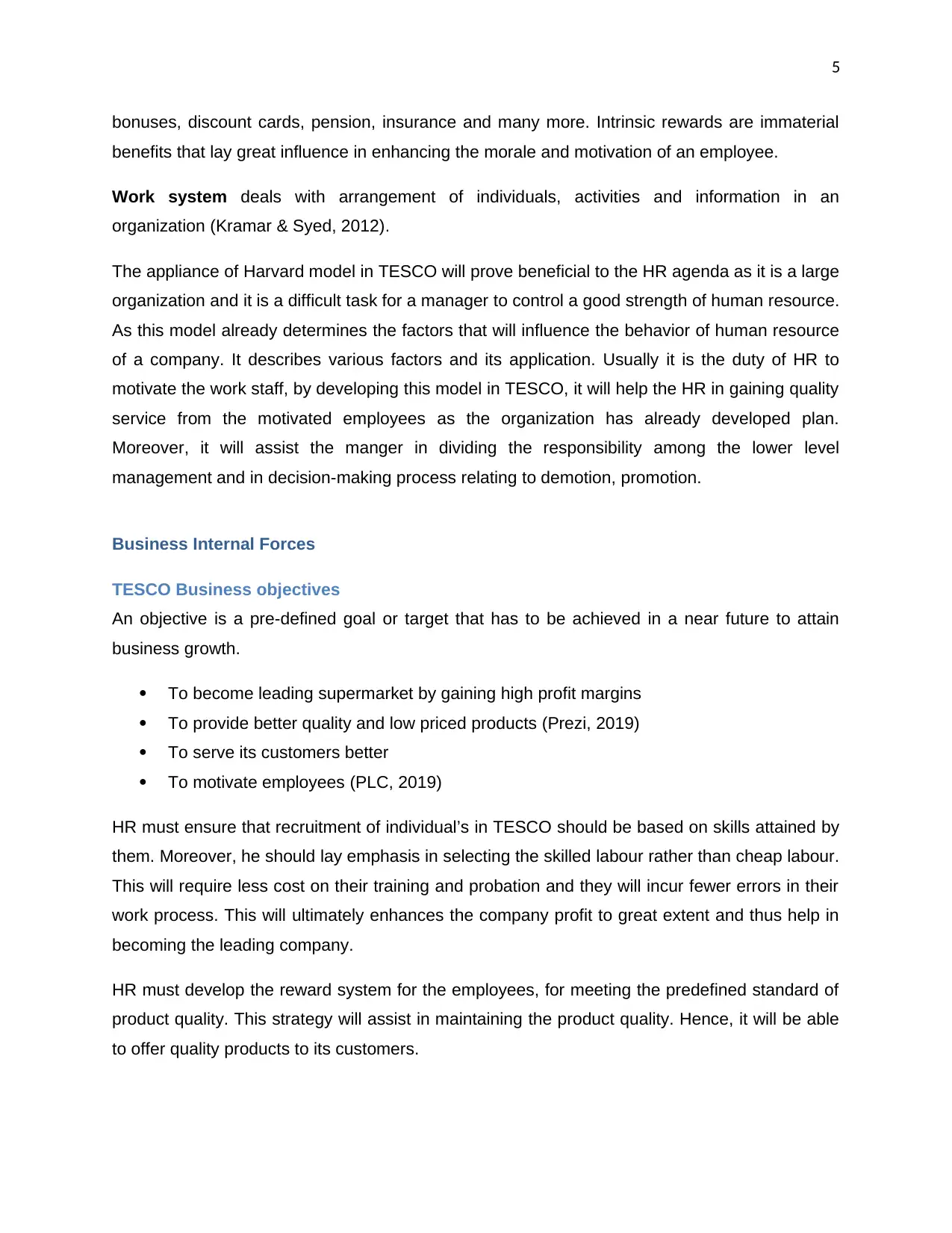
5
bonuses, discount cards, pension, insurance and many more. Intrinsic rewards are immaterial
benefits that lay great influence in enhancing the morale and motivation of an employee.
Work system deals with arrangement of individuals, activities and information in an
organization (Kramar & Syed, 2012).
The appliance of Harvard model in TESCO will prove beneficial to the HR agenda as it is a large
organization and it is a difficult task for a manager to control a good strength of human resource.
As this model already determines the factors that will influence the behavior of human resource
of a company. It describes various factors and its application. Usually it is the duty of HR to
motivate the work staff, by developing this model in TESCO, it will help the HR in gaining quality
service from the motivated employees as the organization has already developed plan.
Moreover, it will assist the manger in dividing the responsibility among the lower level
management and in decision-making process relating to demotion, promotion.
Business Internal Forces
TESCO Business objectives
An objective is a pre-defined goal or target that has to be achieved in a near future to attain
business growth.
To become leading supermarket by gaining high profit margins
To provide better quality and low priced products (Prezi, 2019)
To serve its customers better
To motivate employees (PLC, 2019)
HR must ensure that recruitment of individual’s in TESCO should be based on skills attained by
them. Moreover, he should lay emphasis in selecting the skilled labour rather than cheap labour.
This will require less cost on their training and probation and they will incur fewer errors in their
work process. This will ultimately enhances the company profit to great extent and thus help in
becoming the leading company.
HR must develop the reward system for the employees, for meeting the predefined standard of
product quality. This strategy will assist in maintaining the product quality. Hence, it will be able
to offer quality products to its customers.
bonuses, discount cards, pension, insurance and many more. Intrinsic rewards are immaterial
benefits that lay great influence in enhancing the morale and motivation of an employee.
Work system deals with arrangement of individuals, activities and information in an
organization (Kramar & Syed, 2012).
The appliance of Harvard model in TESCO will prove beneficial to the HR agenda as it is a large
organization and it is a difficult task for a manager to control a good strength of human resource.
As this model already determines the factors that will influence the behavior of human resource
of a company. It describes various factors and its application. Usually it is the duty of HR to
motivate the work staff, by developing this model in TESCO, it will help the HR in gaining quality
service from the motivated employees as the organization has already developed plan.
Moreover, it will assist the manger in dividing the responsibility among the lower level
management and in decision-making process relating to demotion, promotion.
Business Internal Forces
TESCO Business objectives
An objective is a pre-defined goal or target that has to be achieved in a near future to attain
business growth.
To become leading supermarket by gaining high profit margins
To provide better quality and low priced products (Prezi, 2019)
To serve its customers better
To motivate employees (PLC, 2019)
HR must ensure that recruitment of individual’s in TESCO should be based on skills attained by
them. Moreover, he should lay emphasis in selecting the skilled labour rather than cheap labour.
This will require less cost on their training and probation and they will incur fewer errors in their
work process. This will ultimately enhances the company profit to great extent and thus help in
becoming the leading company.
HR must develop the reward system for the employees, for meeting the predefined standard of
product quality. This strategy will assist in maintaining the product quality. Hence, it will be able
to offer quality products to its customers.
⊘ This is a preview!⊘
Do you want full access?
Subscribe today to unlock all pages.

Trusted by 1+ million students worldwide
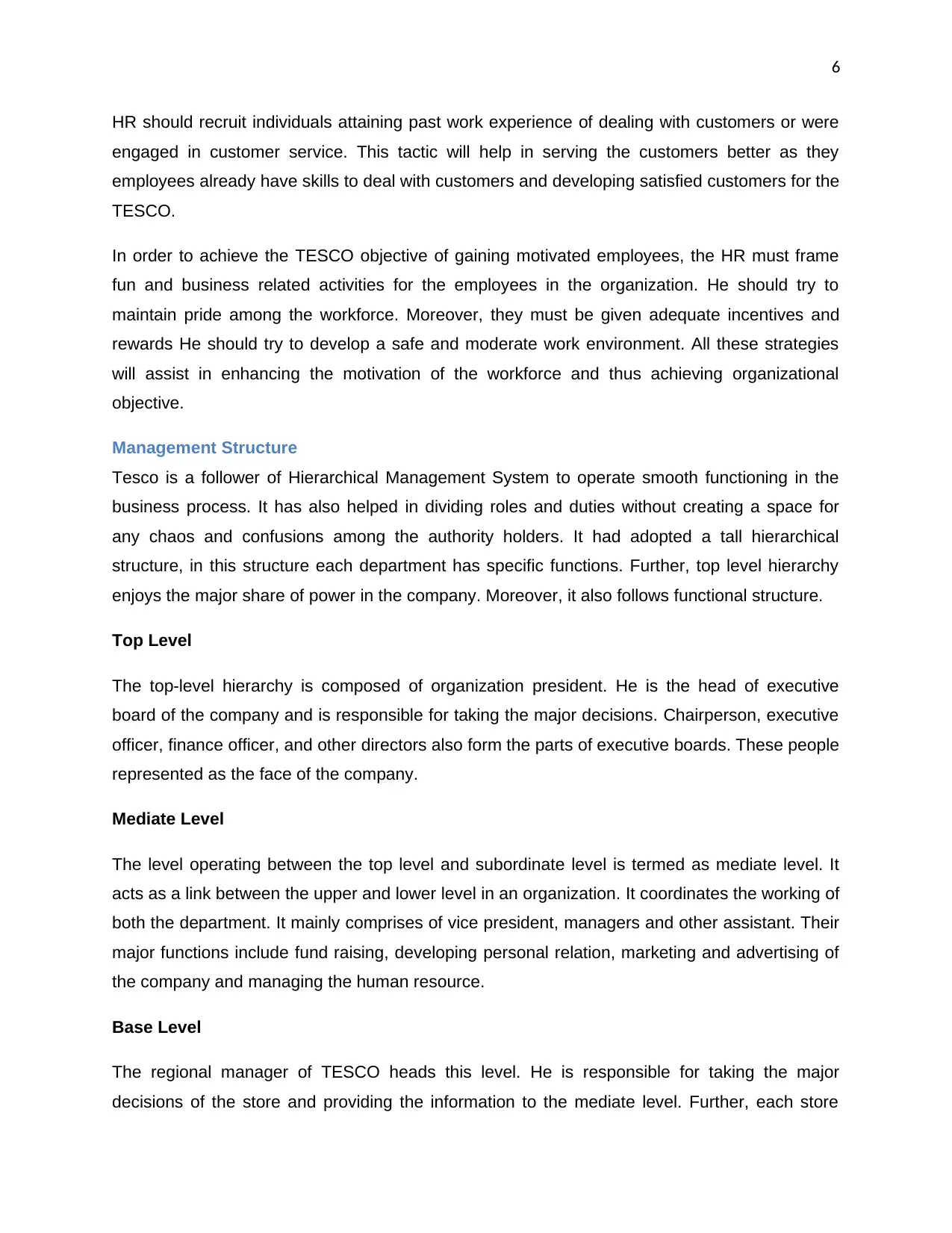
6
HR should recruit individuals attaining past work experience of dealing with customers or were
engaged in customer service. This tactic will help in serving the customers better as they
employees already have skills to deal with customers and developing satisfied customers for the
TESCO.
In order to achieve the TESCO objective of gaining motivated employees, the HR must frame
fun and business related activities for the employees in the organization. He should try to
maintain pride among the workforce. Moreover, they must be given adequate incentives and
rewards He should try to develop a safe and moderate work environment. All these strategies
will assist in enhancing the motivation of the workforce and thus achieving organizational
objective.
Management Structure
Tesco is a follower of Hierarchical Management System to operate smooth functioning in the
business process. It has also helped in dividing roles and duties without creating a space for
any chaos and confusions among the authority holders. It had adopted a tall hierarchical
structure, in this structure each department has specific functions. Further, top level hierarchy
enjoys the major share of power in the company. Moreover, it also follows functional structure.
Top Level
The top-level hierarchy is composed of organization president. He is the head of executive
board of the company and is responsible for taking the major decisions. Chairperson, executive
officer, finance officer, and other directors also form the parts of executive boards. These people
represented as the face of the company.
Mediate Level
The level operating between the top level and subordinate level is termed as mediate level. It
acts as a link between the upper and lower level in an organization. It coordinates the working of
both the department. It mainly comprises of vice president, managers and other assistant. Their
major functions include fund raising, developing personal relation, marketing and advertising of
the company and managing the human resource.
Base Level
The regional manager of TESCO heads this level. He is responsible for taking the major
decisions of the store and providing the information to the mediate level. Further, each store
HR should recruit individuals attaining past work experience of dealing with customers or were
engaged in customer service. This tactic will help in serving the customers better as they
employees already have skills to deal with customers and developing satisfied customers for the
TESCO.
In order to achieve the TESCO objective of gaining motivated employees, the HR must frame
fun and business related activities for the employees in the organization. He should try to
maintain pride among the workforce. Moreover, they must be given adequate incentives and
rewards He should try to develop a safe and moderate work environment. All these strategies
will assist in enhancing the motivation of the workforce and thus achieving organizational
objective.
Management Structure
Tesco is a follower of Hierarchical Management System to operate smooth functioning in the
business process. It has also helped in dividing roles and duties without creating a space for
any chaos and confusions among the authority holders. It had adopted a tall hierarchical
structure, in this structure each department has specific functions. Further, top level hierarchy
enjoys the major share of power in the company. Moreover, it also follows functional structure.
Top Level
The top-level hierarchy is composed of organization president. He is the head of executive
board of the company and is responsible for taking the major decisions. Chairperson, executive
officer, finance officer, and other directors also form the parts of executive boards. These people
represented as the face of the company.
Mediate Level
The level operating between the top level and subordinate level is termed as mediate level. It
acts as a link between the upper and lower level in an organization. It coordinates the working of
both the department. It mainly comprises of vice president, managers and other assistant. Their
major functions include fund raising, developing personal relation, marketing and advertising of
the company and managing the human resource.
Base Level
The regional manager of TESCO heads this level. He is responsible for taking the major
decisions of the store and providing the information to the mediate level. Further, each store
Paraphrase This Document
Need a fresh take? Get an instant paraphrase of this document with our AI Paraphraser
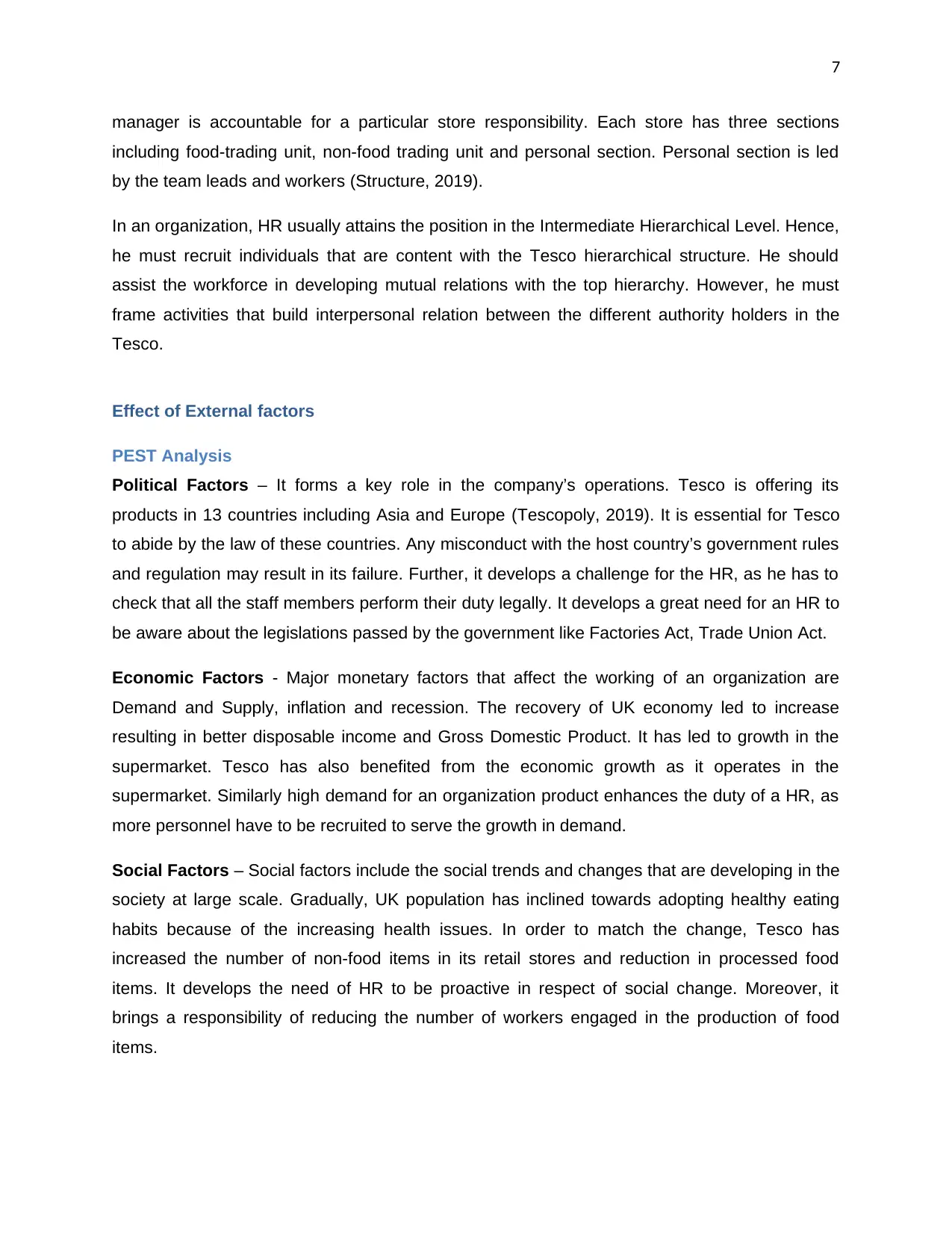
7
manager is accountable for a particular store responsibility. Each store has three sections
including food-trading unit, non-food trading unit and personal section. Personal section is led
by the team leads and workers (Structure, 2019).
In an organization, HR usually attains the position in the Intermediate Hierarchical Level. Hence,
he must recruit individuals that are content with the Tesco hierarchical structure. He should
assist the workforce in developing mutual relations with the top hierarchy. However, he must
frame activities that build interpersonal relation between the different authority holders in the
Tesco.
Effect of External factors
PEST Analysis
Political Factors – It forms a key role in the company’s operations. Tesco is offering its
products in 13 countries including Asia and Europe (Tescopoly, 2019). It is essential for Tesco
to abide by the law of these countries. Any misconduct with the host country’s government rules
and regulation may result in its failure. Further, it develops a challenge for the HR, as he has to
check that all the staff members perform their duty legally. It develops a great need for an HR to
be aware about the legislations passed by the government like Factories Act, Trade Union Act.
Economic Factors - Major monetary factors that affect the working of an organization are
Demand and Supply, inflation and recession. The recovery of UK economy led to increase
resulting in better disposable income and Gross Domestic Product. It has led to growth in the
supermarket. Tesco has also benefited from the economic growth as it operates in the
supermarket. Similarly high demand for an organization product enhances the duty of a HR, as
more personnel have to be recruited to serve the growth in demand.
Social Factors – Social factors include the social trends and changes that are developing in the
society at large scale. Gradually, UK population has inclined towards adopting healthy eating
habits because of the increasing health issues. In order to match the change, Tesco has
increased the number of non-food items in its retail stores and reduction in processed food
items. It develops the need of HR to be proactive in respect of social change. Moreover, it
brings a responsibility of reducing the number of workers engaged in the production of food
items.
manager is accountable for a particular store responsibility. Each store has three sections
including food-trading unit, non-food trading unit and personal section. Personal section is led
by the team leads and workers (Structure, 2019).
In an organization, HR usually attains the position in the Intermediate Hierarchical Level. Hence,
he must recruit individuals that are content with the Tesco hierarchical structure. He should
assist the workforce in developing mutual relations with the top hierarchy. However, he must
frame activities that build interpersonal relation between the different authority holders in the
Tesco.
Effect of External factors
PEST Analysis
Political Factors – It forms a key role in the company’s operations. Tesco is offering its
products in 13 countries including Asia and Europe (Tescopoly, 2019). It is essential for Tesco
to abide by the law of these countries. Any misconduct with the host country’s government rules
and regulation may result in its failure. Further, it develops a challenge for the HR, as he has to
check that all the staff members perform their duty legally. It develops a great need for an HR to
be aware about the legislations passed by the government like Factories Act, Trade Union Act.
Economic Factors - Major monetary factors that affect the working of an organization are
Demand and Supply, inflation and recession. The recovery of UK economy led to increase
resulting in better disposable income and Gross Domestic Product. It has led to growth in the
supermarket. Tesco has also benefited from the economic growth as it operates in the
supermarket. Similarly high demand for an organization product enhances the duty of a HR, as
more personnel have to be recruited to serve the growth in demand.
Social Factors – Social factors include the social trends and changes that are developing in the
society at large scale. Gradually, UK population has inclined towards adopting healthy eating
habits because of the increasing health issues. In order to match the change, Tesco has
increased the number of non-food items in its retail stores and reduction in processed food
items. It develops the need of HR to be proactive in respect of social change. Moreover, it
brings a responsibility of reducing the number of workers engaged in the production of food
items.
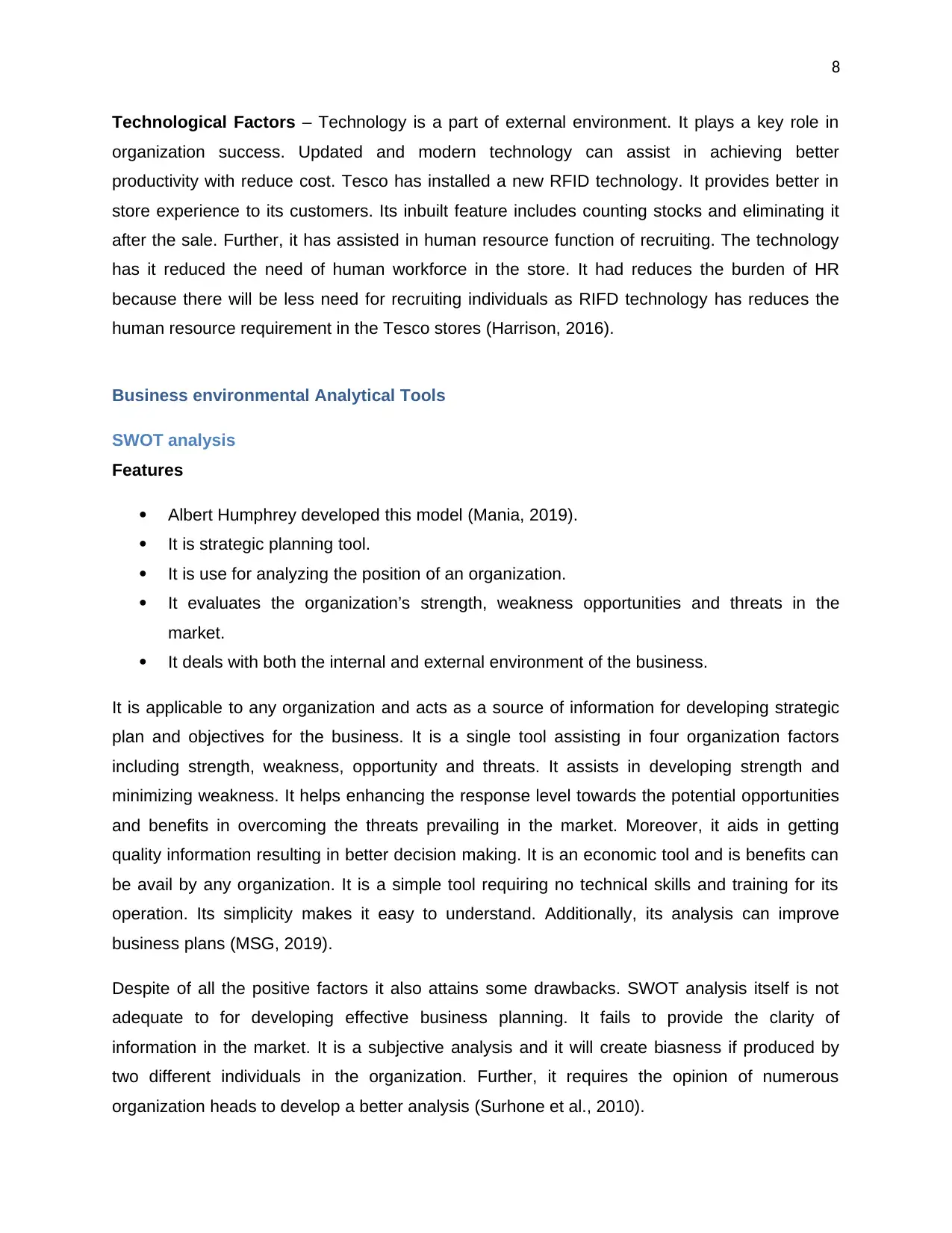
8
Technological Factors – Technology is a part of external environment. It plays a key role in
organization success. Updated and modern technology can assist in achieving better
productivity with reduce cost. Tesco has installed a new RFID technology. It provides better in
store experience to its customers. Its inbuilt feature includes counting stocks and eliminating it
after the sale. Further, it has assisted in human resource function of recruiting. The technology
has it reduced the need of human workforce in the store. It had reduces the burden of HR
because there will be less need for recruiting individuals as RIFD technology has reduces the
human resource requirement in the Tesco stores (Harrison, 2016).
Business environmental Analytical Tools
SWOT analysis
Features
Albert Humphrey developed this model (Mania, 2019).
It is strategic planning tool.
It is use for analyzing the position of an organization.
It evaluates the organization’s strength, weakness opportunities and threats in the
market.
It deals with both the internal and external environment of the business.
It is applicable to any organization and acts as a source of information for developing strategic
plan and objectives for the business. It is a single tool assisting in four organization factors
including strength, weakness, opportunity and threats. It assists in developing strength and
minimizing weakness. It helps enhancing the response level towards the potential opportunities
and benefits in overcoming the threats prevailing in the market. Moreover, it aids in getting
quality information resulting in better decision making. It is an economic tool and is benefits can
be avail by any organization. It is a simple tool requiring no technical skills and training for its
operation. Its simplicity makes it easy to understand. Additionally, its analysis can improve
business plans (MSG, 2019).
Despite of all the positive factors it also attains some drawbacks. SWOT analysis itself is not
adequate to for developing effective business planning. It fails to provide the clarity of
information in the market. It is a subjective analysis and it will create biasness if produced by
two different individuals in the organization. Further, it requires the opinion of numerous
organization heads to develop a better analysis (Surhone et al., 2010).
Technological Factors – Technology is a part of external environment. It plays a key role in
organization success. Updated and modern technology can assist in achieving better
productivity with reduce cost. Tesco has installed a new RFID technology. It provides better in
store experience to its customers. Its inbuilt feature includes counting stocks and eliminating it
after the sale. Further, it has assisted in human resource function of recruiting. The technology
has it reduced the need of human workforce in the store. It had reduces the burden of HR
because there will be less need for recruiting individuals as RIFD technology has reduces the
human resource requirement in the Tesco stores (Harrison, 2016).
Business environmental Analytical Tools
SWOT analysis
Features
Albert Humphrey developed this model (Mania, 2019).
It is strategic planning tool.
It is use for analyzing the position of an organization.
It evaluates the organization’s strength, weakness opportunities and threats in the
market.
It deals with both the internal and external environment of the business.
It is applicable to any organization and acts as a source of information for developing strategic
plan and objectives for the business. It is a single tool assisting in four organization factors
including strength, weakness, opportunity and threats. It assists in developing strength and
minimizing weakness. It helps enhancing the response level towards the potential opportunities
and benefits in overcoming the threats prevailing in the market. Moreover, it aids in getting
quality information resulting in better decision making. It is an economic tool and is benefits can
be avail by any organization. It is a simple tool requiring no technical skills and training for its
operation. Its simplicity makes it easy to understand. Additionally, its analysis can improve
business plans (MSG, 2019).
Despite of all the positive factors it also attains some drawbacks. SWOT analysis itself is not
adequate to for developing effective business planning. It fails to provide the clarity of
information in the market. It is a subjective analysis and it will create biasness if produced by
two different individuals in the organization. Further, it requires the opinion of numerous
organization heads to develop a better analysis (Surhone et al., 2010).
⊘ This is a preview!⊘
Do you want full access?
Subscribe today to unlock all pages.

Trusted by 1+ million students worldwide
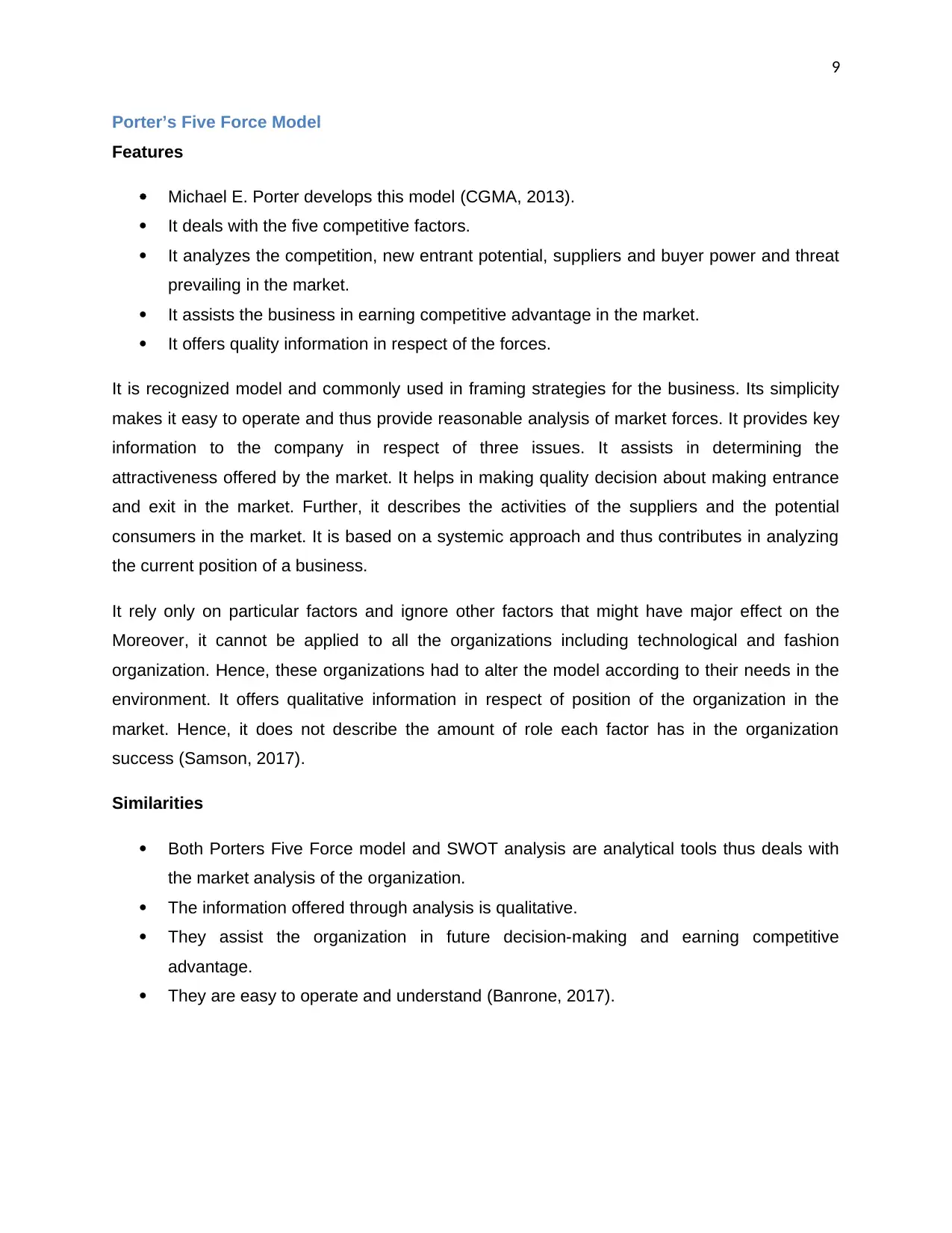
9
Porter’s Five Force Model
Features
Michael E. Porter develops this model (CGMA, 2013).
It deals with the five competitive factors.
It analyzes the competition, new entrant potential, suppliers and buyer power and threat
prevailing in the market.
It assists the business in earning competitive advantage in the market.
It offers quality information in respect of the forces.
It is recognized model and commonly used in framing strategies for the business. Its simplicity
makes it easy to operate and thus provide reasonable analysis of market forces. It provides key
information to the company in respect of three issues. It assists in determining the
attractiveness offered by the market. It helps in making quality decision about making entrance
and exit in the market. Further, it describes the activities of the suppliers and the potential
consumers in the market. It is based on a systemic approach and thus contributes in analyzing
the current position of a business.
It rely only on particular factors and ignore other factors that might have major effect on the
Moreover, it cannot be applied to all the organizations including technological and fashion
organization. Hence, these organizations had to alter the model according to their needs in the
environment. It offers qualitative information in respect of position of the organization in the
market. Hence, it does not describe the amount of role each factor has in the organization
success (Samson, 2017).
Similarities
Both Porters Five Force model and SWOT analysis are analytical tools thus deals with
the market analysis of the organization.
The information offered through analysis is qualitative.
They assist the organization in future decision-making and earning competitive
advantage.
They are easy to operate and understand (Banrone, 2017).
Porter’s Five Force Model
Features
Michael E. Porter develops this model (CGMA, 2013).
It deals with the five competitive factors.
It analyzes the competition, new entrant potential, suppliers and buyer power and threat
prevailing in the market.
It assists the business in earning competitive advantage in the market.
It offers quality information in respect of the forces.
It is recognized model and commonly used in framing strategies for the business. Its simplicity
makes it easy to operate and thus provide reasonable analysis of market forces. It provides key
information to the company in respect of three issues. It assists in determining the
attractiveness offered by the market. It helps in making quality decision about making entrance
and exit in the market. Further, it describes the activities of the suppliers and the potential
consumers in the market. It is based on a systemic approach and thus contributes in analyzing
the current position of a business.
It rely only on particular factors and ignore other factors that might have major effect on the
Moreover, it cannot be applied to all the organizations including technological and fashion
organization. Hence, these organizations had to alter the model according to their needs in the
environment. It offers qualitative information in respect of position of the organization in the
market. Hence, it does not describe the amount of role each factor has in the organization
success (Samson, 2017).
Similarities
Both Porters Five Force model and SWOT analysis are analytical tools thus deals with
the market analysis of the organization.
The information offered through analysis is qualitative.
They assist the organization in future decision-making and earning competitive
advantage.
They are easy to operate and understand (Banrone, 2017).
Paraphrase This Document
Need a fresh take? Get an instant paraphrase of this document with our AI Paraphraser
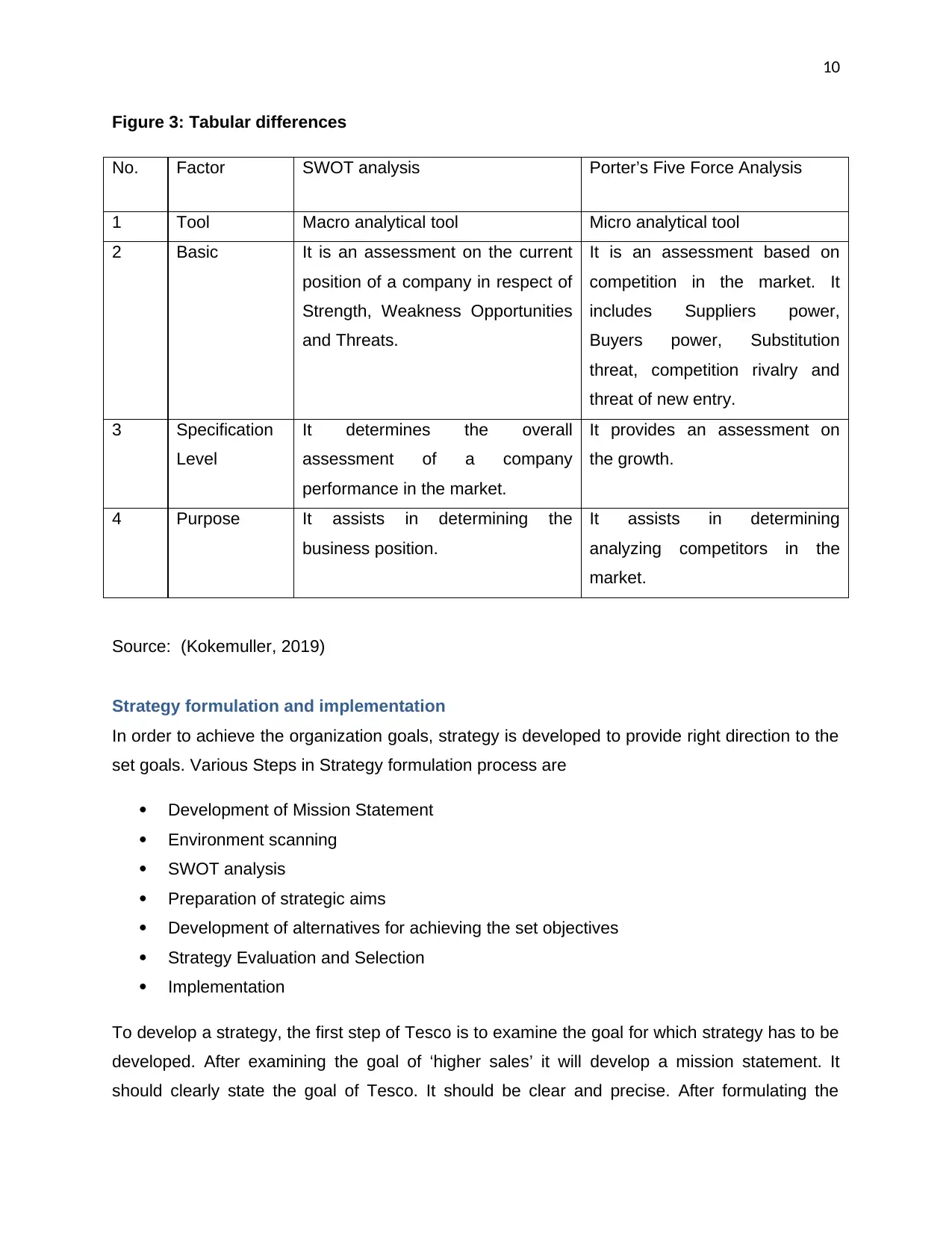
10
Figure 3: Tabular differences
No. Factor SWOT analysis Porter’s Five Force Analysis
1 Tool Macro analytical tool Micro analytical tool
2 Basic It is an assessment on the current
position of a company in respect of
Strength, Weakness Opportunities
and Threats.
It is an assessment based on
competition in the market. It
includes Suppliers power,
Buyers power, Substitution
threat, competition rivalry and
threat of new entry.
3 Specification
Level
It determines the overall
assessment of a company
performance in the market.
It provides an assessment on
the growth.
4 Purpose It assists in determining the
business position.
It assists in determining
analyzing competitors in the
market.
Source: (Kokemuller, 2019)
Strategy formulation and implementation
In order to achieve the organization goals, strategy is developed to provide right direction to the
set goals. Various Steps in Strategy formulation process are
Development of Mission Statement
Environment scanning
SWOT analysis
Preparation of strategic aims
Development of alternatives for achieving the set objectives
Strategy Evaluation and Selection
Implementation
To develop a strategy, the first step of Tesco is to examine the goal for which strategy has to be
developed. After examining the goal of ‘higher sales’ it will develop a mission statement. It
should clearly state the goal of Tesco. It should be clear and precise. After formulating the
Figure 3: Tabular differences
No. Factor SWOT analysis Porter’s Five Force Analysis
1 Tool Macro analytical tool Micro analytical tool
2 Basic It is an assessment on the current
position of a company in respect of
Strength, Weakness Opportunities
and Threats.
It is an assessment based on
competition in the market. It
includes Suppliers power,
Buyers power, Substitution
threat, competition rivalry and
threat of new entry.
3 Specification
Level
It determines the overall
assessment of a company
performance in the market.
It provides an assessment on
the growth.
4 Purpose It assists in determining the
business position.
It assists in determining
analyzing competitors in the
market.
Source: (Kokemuller, 2019)
Strategy formulation and implementation
In order to achieve the organization goals, strategy is developed to provide right direction to the
set goals. Various Steps in Strategy formulation process are
Development of Mission Statement
Environment scanning
SWOT analysis
Preparation of strategic aims
Development of alternatives for achieving the set objectives
Strategy Evaluation and Selection
Implementation
To develop a strategy, the first step of Tesco is to examine the goal for which strategy has to be
developed. After examining the goal of ‘higher sales’ it will develop a mission statement. It
should clearly state the goal of Tesco. It should be clear and precise. After formulating the
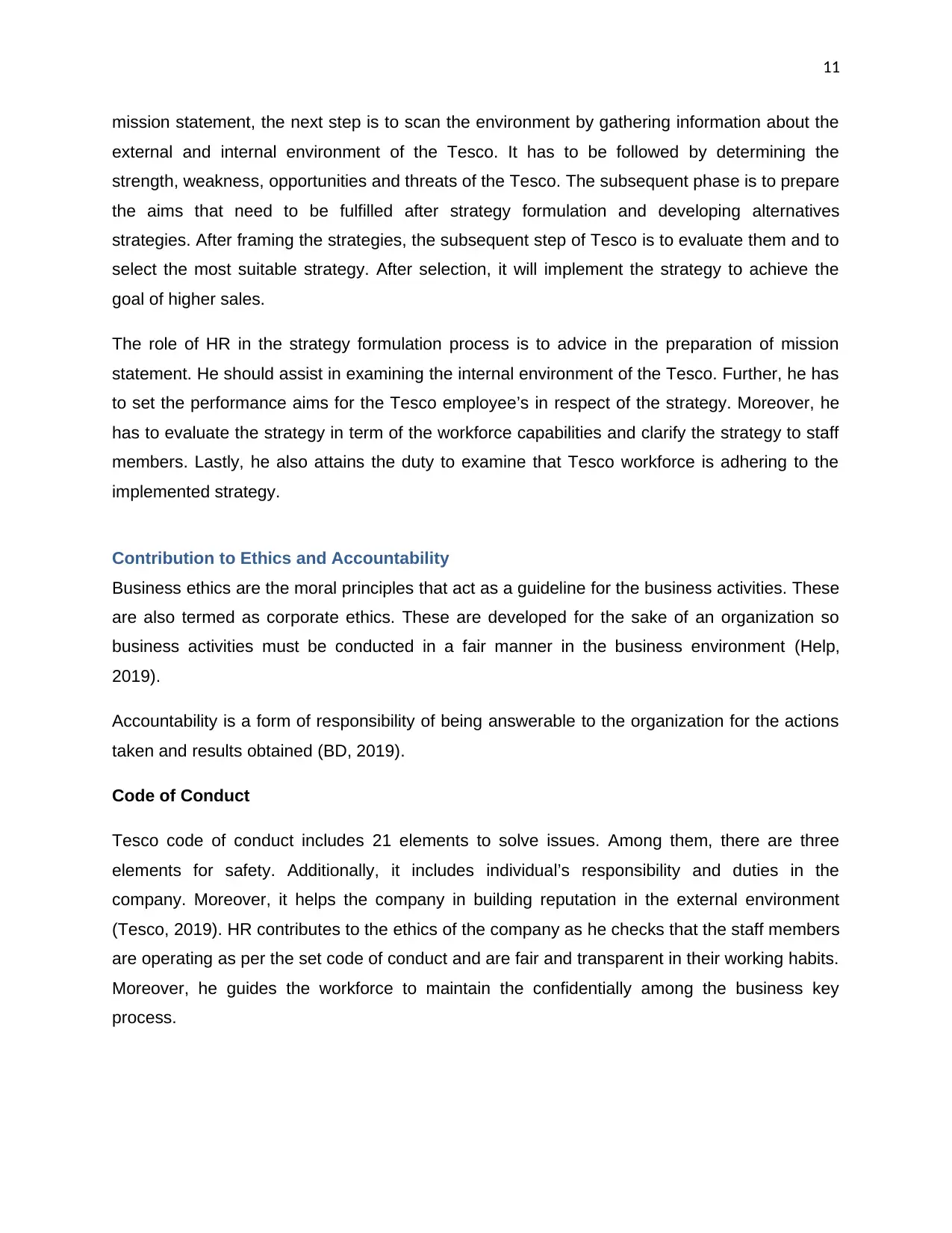
11
mission statement, the next step is to scan the environment by gathering information about the
external and internal environment of the Tesco. It has to be followed by determining the
strength, weakness, opportunities and threats of the Tesco. The subsequent phase is to prepare
the aims that need to be fulfilled after strategy formulation and developing alternatives
strategies. After framing the strategies, the subsequent step of Tesco is to evaluate them and to
select the most suitable strategy. After selection, it will implement the strategy to achieve the
goal of higher sales.
The role of HR in the strategy formulation process is to advice in the preparation of mission
statement. He should assist in examining the internal environment of the Tesco. Further, he has
to set the performance aims for the Tesco employee’s in respect of the strategy. Moreover, he
has to evaluate the strategy in term of the workforce capabilities and clarify the strategy to staff
members. Lastly, he also attains the duty to examine that Tesco workforce is adhering to the
implemented strategy.
Contribution to Ethics and Accountability
Business ethics are the moral principles that act as a guideline for the business activities. These
are also termed as corporate ethics. These are developed for the sake of an organization so
business activities must be conducted in a fair manner in the business environment (Help,
2019).
Accountability is a form of responsibility of being answerable to the organization for the actions
taken and results obtained (BD, 2019).
Code of Conduct
Tesco code of conduct includes 21 elements to solve issues. Among them, there are three
elements for safety. Additionally, it includes individual’s responsibility and duties in the
company. Moreover, it helps the company in building reputation in the external environment
(Tesco, 2019). HR contributes to the ethics of the company as he checks that the staff members
are operating as per the set code of conduct and are fair and transparent in their working habits.
Moreover, he guides the workforce to maintain the confidentially among the business key
process.
mission statement, the next step is to scan the environment by gathering information about the
external and internal environment of the Tesco. It has to be followed by determining the
strength, weakness, opportunities and threats of the Tesco. The subsequent phase is to prepare
the aims that need to be fulfilled after strategy formulation and developing alternatives
strategies. After framing the strategies, the subsequent step of Tesco is to evaluate them and to
select the most suitable strategy. After selection, it will implement the strategy to achieve the
goal of higher sales.
The role of HR in the strategy formulation process is to advice in the preparation of mission
statement. He should assist in examining the internal environment of the Tesco. Further, he has
to set the performance aims for the Tesco employee’s in respect of the strategy. Moreover, he
has to evaluate the strategy in term of the workforce capabilities and clarify the strategy to staff
members. Lastly, he also attains the duty to examine that Tesco workforce is adhering to the
implemented strategy.
Contribution to Ethics and Accountability
Business ethics are the moral principles that act as a guideline for the business activities. These
are also termed as corporate ethics. These are developed for the sake of an organization so
business activities must be conducted in a fair manner in the business environment (Help,
2019).
Accountability is a form of responsibility of being answerable to the organization for the actions
taken and results obtained (BD, 2019).
Code of Conduct
Tesco code of conduct includes 21 elements to solve issues. Among them, there are three
elements for safety. Additionally, it includes individual’s responsibility and duties in the
company. Moreover, it helps the company in building reputation in the external environment
(Tesco, 2019). HR contributes to the ethics of the company as he checks that the staff members
are operating as per the set code of conduct and are fair and transparent in their working habits.
Moreover, he guides the workforce to maintain the confidentially among the business key
process.
⊘ This is a preview!⊘
Do you want full access?
Subscribe today to unlock all pages.

Trusted by 1+ million students worldwide
1 out of 20
Related Documents
Your All-in-One AI-Powered Toolkit for Academic Success.
+13062052269
info@desklib.com
Available 24*7 on WhatsApp / Email
![[object Object]](/_next/static/media/star-bottom.7253800d.svg)
Unlock your academic potential
Copyright © 2020–2025 A2Z Services. All Rights Reserved. Developed and managed by ZUCOL.




